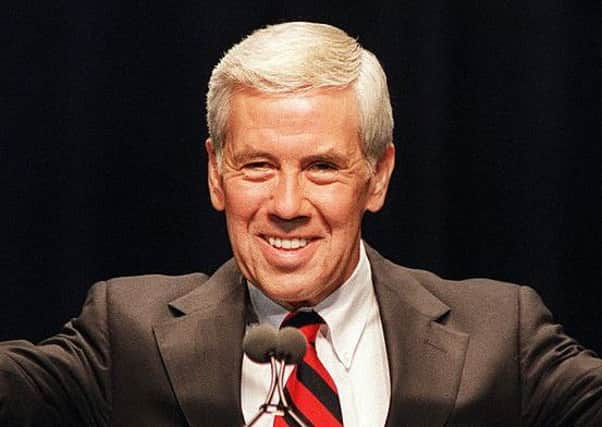Obituary: Richard Lugar, US senator who worked to dismantle former Soviet nuclear arms


The longtime Republican senator from Indiana helped start a programme that destroyed thousands of former Soviet nuclear and chemical weapons after the Cold War ended – then warned during a short-lived 1996 run for president about the danger of such devices falling into the hands of terrorists.
“Every stockpile represents a theft opportunity for terrorists and a temptation for security personnel who might seek to profit by selling weapons on the black market,” Lugar said in 2005. “We do not want the question posed the day after an attack on an American military base.”
Advertisement
Hide AdAdvertisement
Hide AdThe soft-spoken and thoughtful former Rhodes scholar was a leading Republican voice on foreign policy matters during his 36 years in the US Senate, but whose reputation of working with Democrats ultimately cost him the office in 2012.
He died at age 87 at a hospital in Virginia, where he was being treated for a rare neurological disorder, chronic inflammatory demylinating polyneuropathy.
Lugar’s long popularity in Indiana gave him the freedom to concentrate largely on foreign policy and national security matters – a focus highlighted by his collaboration with Democrats Senator Sam Nunn on a programme under which the US paid to dismantle and secure thousands of nuclear warheads and missiles in the former Soviet states after the Cold War.
Lugar served for decades on the Senate Foreign Relations Committee, twice as chairman, where he helped steer arms reduction pacts for the presidential administrations of George HW Bush, Bill Clinton and Barack Obama, supported an expansion of Nato and favoured aid to Nicaragua’s Contra rebels.
“Lugar was a leader not only in the Senate but also on the world stage, where he worked tirelessly to bring pressure to end apartheid in South Africa and enforce treaties that destroyed Soviet weapons of mass destruction,” Vice President Mike Pence, a former governor of Indiana, said.
Another former governor, Purdue University president Mitch Daniels, who spent more than a decade as chief of staff to Lugar, said, “The world is safer from nuclear danger because of him.”
Lugar tried to translate his foreign policy expertise into a 1996 presidential run. But his campaign went badly from the start. His opening rally began just hours after the 1995 bombing of the Oklahoma City federal building, and he struggled to build name recognition and support.
He withdrew a year into the race after failing to win a single convention delegate, but not before foreshadowing the threat of terrorism that would become all too real on September 11, 2001. Three of his television ads depicted mushroom clouds and warned of the growing danger of weapons of mass destruction in the hands of terrorist groups.
Advertisement
Hide AdAdvertisement
Hide AdLugar’s time as a Washington foreign policy expert was the highlight of a political career that began with his election to the Indianapolis school board in the early 1960s. City GOP leaders encouraged him to run for mayor in 1967. He spent eight years at the city’s helm.
He first ran for the Senate in 1974, narrowly losing to Senator Birch Bayh in a Democratic landslide after the Watergate scandal. He ran again two years later and easily unseated three-term Democratic Senator Vance Hartke, launching a 36-year Capitol Hill career that made him Indiana’s longest-serving senator.
He built a reputation as someone willing to work across the aisle and showed he could buck his party, notably two major disagreements with President Ronald Reagan.
In 1986, Reagan was inclined to accept the rigged election that would have kept Philippines president Ferdinand Marcos in office. But Lugar went to the islands as an election observer and said Reagan was misinformed. Lugar’s stand shifted US support to the ultimate winner, Corazon Aquino, bringing down Marcos.
In another break with Reagan, Lugar pushed through Congress – over the president’s veto – the economic sanctions that Nelson Mandela said played a crucial role in overthrowing white minority rule in South Africa.
At home, Lugar remained the Indiana GOP’s most popular figure, trouncing opponents with at least two-thirds of the vote in four straight elections.
He was the top Republican on the Senate’s Foreign Affairs Committee when he first worked with Obama, taking the then-Illinois senator with him to Russia, Ukraine and Azerbaijan in 2005 to visit weapon dismantling sites. He then co-sponsored 2007 legislation with Obama on eliminating stockpiles of shoulder-fired missiles.
Obama frequently cited his work with Lugar during the 2008 presidential campaign as evidence of his bipartisanship and foreign policy experience. Lugar endorsed John McCain but didn’t distance himself from Obama at the time.
Advertisement
Hide AdAdvertisement
Hide AdThat changed by Lugar’s 2012 re-election campaign. The attacks on his conservatism – combined with voter wariness about his age and long Washington tenure and questions about him not owning a home in Indiana since the late 1970s – led to Lugar’s first defeat since 1974. His tea party-backed challenger, Richard Mourdock, grabbed 60 per cent of the GOP primary vote.
Lugar’s nuclear disarmament work with Nunn led to about 7,600 Soviet nuclear warheads being deactivated and the destruction of more than 900 intercontinental ballistic missiles by the time he left office, according to US military figures. The programme is credited with removing all nuclear weapons from the former Soviet republics of Kazakhstan, Ukraine and Belarus.
Born April 4, 1932, in Indianapolis, Lugar graduated at the top of his classes at both Indianapolis Shortridge High School and Denison University, Ohio, where he met future wife Charlene. They married in 1956 and had four sons.
TOM DAVIES